13 Types of Azaleas for a Pretty & Low Maintenance Garden
Author: Jen Worst | Editor: Omar Alonso
Review & Research: Jen Worst & Chris Miller
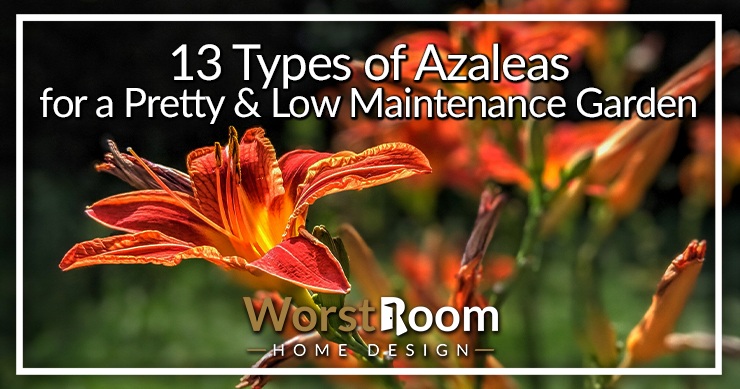
For most people in the United States, it's impossible to think of springtime without different types of azaleas flowering in gardens, parks, hedges, reflecting pools, or ponds. Azalea flowers are valued for their beautiful shape and gorgeous splashes of colors.
Since the plant has been bred for centuries, there are many azalea colors available in the Northern Hemisphere. Azalea flowers are available in shades of pink, yellow, orange, red, purple, and white colors.
Most Azalea shrubs don't grow much in length. So, they are undoubtedly a great choice to grow in your garden containers and flower beds.
If you want to grow different azalea varieties in your garden, you need to know all the notable characteristics of the varieties, including the flower type, growing needs, blooming time, etc.
Here we will provide you with all such information about various azaleas so that you can decide which one to pick. Let's dive right in.
13 Types of Azaleas
More than 10,000 different azalea varieties have been registered till now, and as the Ericaceae family they've been dated to 70 million years old. The varieties largely vary in their habits, habitats, colors, bloom times, and sizes.
Below we have rounded up the best types of azalea bushes that produce beautiful blooms and are easy to grow. Let's take a look at these azalea species…
Coast Azalea
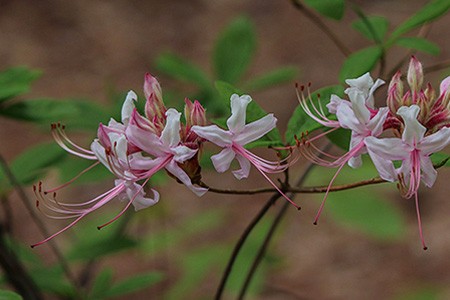
A colony-forming shrub, this dwarf variety of azalea is a perfect plant to grow on the moist borders of your garden. Coast Azaleas can reach up to 5 feet in height, but most of these azalea types grow only 1-3 feet.
Although the plant prefers partial shade, it's more tolerant to the sun than many other varieties. To grow this azalea shrub, you have to ensure that the soil is well-drained and always moist. The flowers of Coast Azaleas are small and white with pink borders.
You can expect the plant to bloom during April. One identifying feature of this azalea is the leaves. These leaves are dark green with a bluish tint. Both the flowers and these unique-looking leaves make this azalea an excellent ornamental plant.
Northern Hi-Lights Azalea
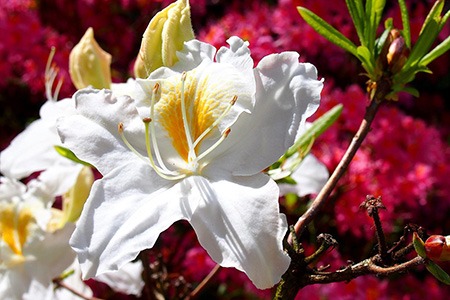
While most flowering plants aren't tolerant of excessive cold, Northern Hi-Lights can survive brutally cold winters. This plant is beloved for both its gorgeous leaves and flowers. During the fall, the mildew-resistant foliage turns stunning burgundy red.
As for the flowers, they can be cream or pale yellow in color with bright yellow splashes on some petals. Besides this delightful look, the flowers also have a sweet fragrance that attracts butterflies and bees to your garden.
The Northern Hi-Lights grow well in partial shade or full sun. You need to water the plant regularly to prevent it from drying out. This deciduous shrub blooms during April and May, and it can grow 4 to 5 feet in length.
Autumn Bonfire Azalea
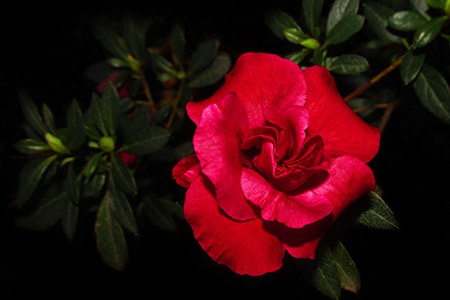
It doesn't feel like autumn if you don't have fiery red blooms in your garden. The multi-seasoned flowers of Autumn Bonfire Azalea emerge with single & semi-double bright red petals. These types of azaleas can look incredible grown into types of hedges or as a hedge itself.
What makes this repeat bloomer even better is that it blooms during spring, summer, and fall. Also, it can resist both heat and cold. When this azalea isn't flowering, its striking green leaves provide an excellent backdrop throughout the year.
The Autumn Bonfire is a dwarf azalea and grows only up to 3 feet in height. It prefers partial shade, but it also loves full sun. You need to plant it in moist, well-drained soil for the best results. All the names of azaleas in the autumn series have such cool names.
Duc De Rohan Azalea
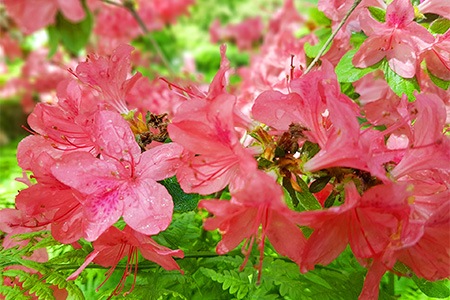
Want an Azalea for bonsai cultivation? Then the Duc De Rohan Azalea will be an ideal choice as it spreads wider than its length. This plant is a slow grower, and you need to train and prune it regularly to turn it into a bonsai tree. Also, root trimming every 3 to 4 years is required to keep its growth compact and restrained.
In ideal conditions, this upright evergreen azalea grows 2 to 3 feet long. The plant is tolerant to heat and thrives in partial shade to full sun.
During the spring, the plant blooms salmon-pink flowers with rose pink blotches in the center. Moreover, the dark green leaves add to the beauty of the plant, making it a perfect choice for landscapes and borders.
Electric Lights Double Pink Azalea
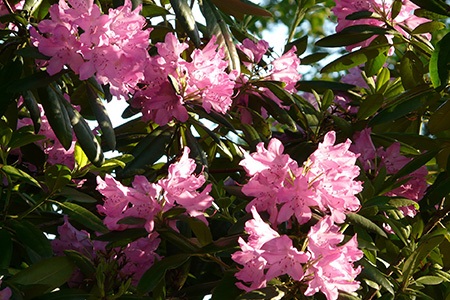
From the azalea breeding program of the University of Minnesota comes the very first double-flowered form of azalea. Clusters of these fragrant, double pink flowers with fluffy, blush pink petals bloom during the spring. The light green leaves also join the party in the fall when they turn Burgundy.
Electric Lights Double Pink Azalea is a slow grower like most azalea varieties and reaches 6 to 7 feet long. The deciduous plant prefers partial shade and tolerates morning sun. With its gorgeous pink flowers, the plant works as an amazing centerpiece for island beds and flowering hedges.
Lemon Lights Azalea
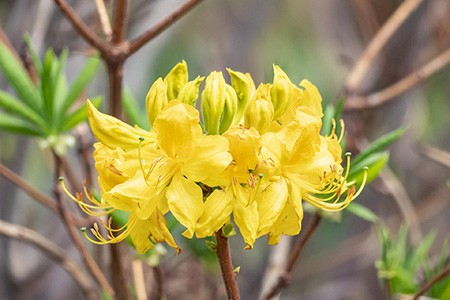
Welcoming the spring with clusters of yellow-cream blooms, flowering Lemon Light Azalea is a treat to the eyes. The plant, with its cold-hardy strength, thrives even at -20 degrees Fahrenheit! Besides cold, the plant is also good at tolerating high humidity and excessive heat.
When matured, the plant grows 4 to 5 feet tall. If you live in a particularly cold area, it's better to plant it in partially shady areas. However, the plant grows well in full sun too. The deciduous plant prefers moist, acidic soil with added humus.
Regular watering is a must to keep the roots of these types of azaleas alive. This slow-growing plant takes one year or more to bloom. With its huge trumpet-shaped yellow flowers, the plant is a genius choice to cover your garden with a blanket of vibrancy.
Flame Azalea
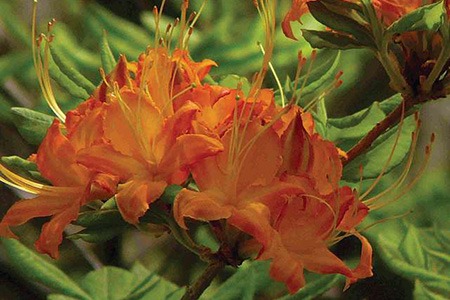
Native to the northern part of America, the Flame Azalea is identified by its 1 to 3 inches long leaves that turn yellow during the fall. This plant isn't heat-tolerant, and it won't survive in regions that are hotter than zone 7.
While most azaleas need moist soil and regular watering to thrive, Flame Azalea prefers moderately moist soil as its roots don't prefer sitting in water. The spread of a matured Flame Azalea is 8 to 10 feet, whereas the length is only 4 to 8 feet.
As for the flowers, they are non-fragrant and bloom from May to June. The name 'Flame Azalea' refers to the reddish-yellow color and funnel-like shape of the flower.
Keep in mind that all parts of this azalea are toxic. So, you need to be extra careful while growing them if you have kids or pets at home.
Rhododendron ‘Blue Tit' Azalea
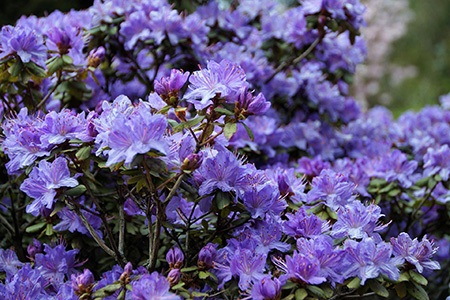
The Rhododendron ‘Blue Tit' Azalea is a mounding, compact, evergreen, dense shrub that is valued for its unique lavender-blue flower clusters. In the mid-spring, each cluster provides 3 to 5 trumpet-shaped flowers.
This evergreen plant grows 2 to 3 feet tall. If you want to grow these azalea types, you should remember that it's a needy plant. The plant prefers partial shade and acidic soil. You need to protect it from frost to prevent any damage to the flowers.
The roots of this azalea won't survive without water. So, you need to plant it in moist, rich, and fertile soil. Besides, annual mulching is also required to cool the soil, control weeds, and retain moisture. It's one of the types of rhododendron, which are different but extremely similar to azaleas with abundant hybrids between them.
Fireball Azalea
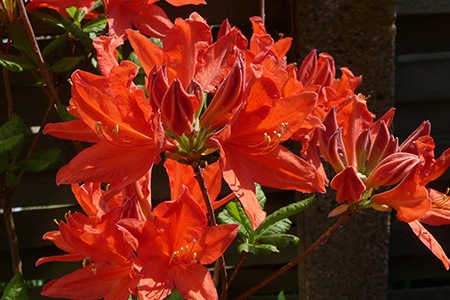
Ideal for brightening your semi-shade gardens, Fireball Azalea delivers an explosion of red and orange blooms during late spring. Unlike most azaleas, Fireball is a fast grower and early bloomer. The upright growth habit of this plant makes it a standout among other spring flowers in your garden.
Since the Fireball Azalea species is a low-maintenance plant, it's a good choice for beginners. It can tolerate cold and grow well in moist, slightly acidic soil. You can grow this plant in sunny and shady areas of your garden.
Along with the flowers, the leaves of these types of azaleas are also of great ornamental value. During the early stages, the foliage color is light bronze that turns green over time. In the fall, this plant displays a great show of bronzed purple-red foliage.
Royal Azalea
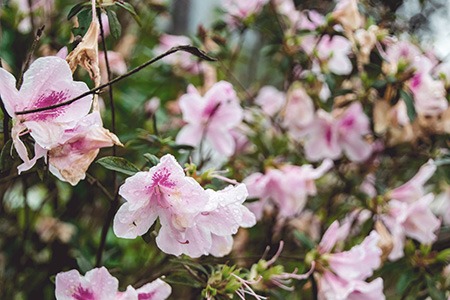
If you have a tight space in your garden, Royal Azaleas are the perfect plants to grow. At maturity, the plant only reaches 3 feet in length. Its rounded spread habit makes it ideal for containers, shrub borders, and small shade gardens.
One noticeable difference between the Royal Azalea and its counterparts is that this plant is much more tolerant. It grows well both in acidic and neutral soil. Plus, the plant shows great resistance to heat and cold.
Flowers arrive in April and May with their strong and sweet fragrance. The white blooms with bold pink accents will surely turn heads. Moreover, the leaves of this deciduous plant display excellent shades of yellow, orange, and red during the fall.
Swamp Azalea
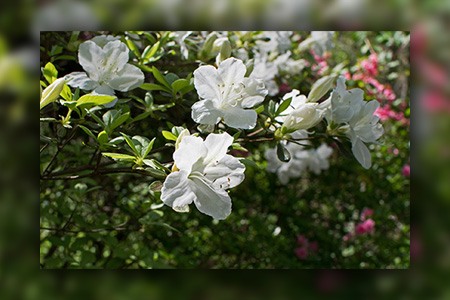
This exceptionally cold-hardy azalea is loved for its strong scented flowers and leaves. It can withstand low temperatures up to -20 degrees Fahrenheit. Like most azaleas, this plant prefers partial shade, humus-laden, and moist soil.
Although it grows best in well-drained soil, Swamp Azaleas tolerate poor-drained soils too. What makes this plant unique is that it can withstand wet soil and periodic floods. However, it's certainly not a good idea to keep it underwater permanently.
Swamp Azaleas are one of the tallest varieties growing up to 8 feet tall and 10 feet wide. The elegant white flowers are small, funnel-shaped, and held in clusters of 3 to 12 flowers.
In early summer, the leaves of this azalea exude clove-like perfume. The leaves also deliver an amazing colorful show when they turn purple, orange, or yellow during the fall. I had a neighbor once with Swamp Azalea bushes grown up tall with types of allium flowers growing along the ground in front, which looked great.
Formosa Azalea
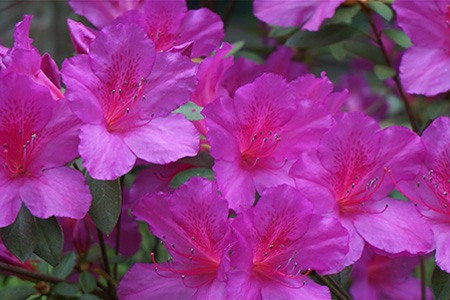
The Formosa Azalea boasts the richest pink color flowers that can push into the deep purple territory, too. The petals are slightly ruffled and in the trumpet shape. If you grow this azalea, expect it to reach between 6 and 8 feet in height.
The nice thing is it won't drop it's green leaves, so though the flowers may fall away, you'll have a green plant to enjoy all year round. But once early spring arrives again, you're going to enjoy the wonderful colors it can bring to your flower bed.
Golden Lights Rhododendron
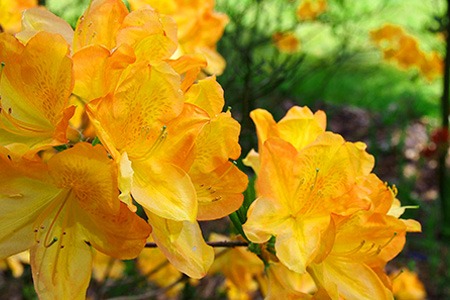
These types of azalea bushes are cultivars that were developed to be cold-hardy and give off huge amounts of beautiful orange and peach blossoms. Each bloom will contain up to 10 flowers of the classic trumpet shape.
The clusters will feature petals that are ruffled, providing much more visual texture. And more so, since it is a compact azalea shrub, growing only between 3 to 6 feet in height and no more than 5 feet in width.
More Types of Azaleas
We can't possibly list all the names of azaleas, let alone discuss all the various azalea types like we did above. But we can share a handful more azalea species to keep your journey exciting as you branch out further and further. By the way, do you know the story of how this became the official state wildflower of Georgia in the United States?
Encore Azaleas - The Encore azalea series includes the "autumn" rhododendrons such as "Autumn Lilac", "Autumn Fire", "Autumn Ruby", "Autumn Sunburst", and "Autumn Chiffon.
Orange to Red Group Azaleas - R. calendulaceum, R. flammeum, R. prunifolium, R. cumberlandense, and R. austrinum.
Pink Group Azaleas - The pink species of azaleas include R. vaseyi, R. periclymenoides, R. canadense, R. canescens, and R. prinophyllum.
White Group Azaleas - These grow great in North America and Europe. They include R. occidentale, R. eastmanii, R. atlanticum, R. alabmense, R. arborescens, R. viscosum, and R. colemanii.
Deciduous Hybrid Azaleas - There are thousands of cultivars, but to mention some: Rhododendron "Homebush", R. "Klondyke", R. Narcissiflorum, "Weston's Innocence", and R. "Mount Saint Helens".
Japanese Azaleas - Azalea Japonica "Girard's Rose" and Satsuki Evergreen Azaleas (including Gumpo Satsuke azalea, Kazan azalea, and Aikoku Japanese azalea).
Dwarf Azalea Shrubs - Great for containers and small flower beds: R. "Princess Anne", R. "April Rose", and R. "Percy-Wiseman".
Dodd Confederate Azaleas - These are hard to grow and may be best avoided. They include R. "Admiral Franklin Buchanan", R. "Stonewall Jackson", and R. "Admiral Semmes" to name a few.
That should keep any azalea enthusiasts busy hunting down all of these azalea colors and varieties. You'll find colors that suit you and grow well in your local environment, so keep the search alive until you're satisfied.
Types of Azaleas for an Incredible Flower Bed
We have included azalea varieties of many different stunning azalea colors and shapes. Hopefully, you'll find the perfect variety for your garden that catches everyone's eyes and pleases your soul.
So there you have some most common, easy-growing, different types of azaleas. If you're looking for a low-maintenance flower for your garden, front yard, or patios, azaleas are simply the best plants to grow.



